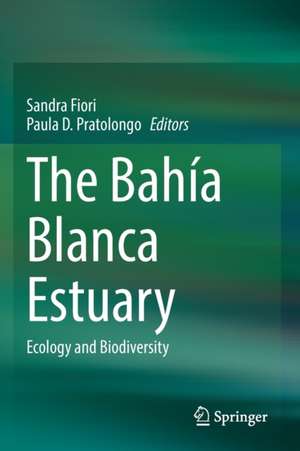The Bahía Blanca Estuary: Ecology and Biodiversity
Editat de Sandra M. Fiori, Paula D. Pratolongoen Limba Engleză Paperback – 5 aug 2022
Beyond its ecological relevance, the Bahía Blanca Estuary is under increasing anthropogenic pressure from large urban settlements, industrial developments and harbors, raising the question of how to balance conservation and development. The Bahía Blanca Estuary: Ecology and Biodiversity offers a comprehensive review of life in the ecosystems of the estuary. The book is divided into five major sections, the first of which provides a description of the regional setting and covers key aspects of estuarine dynamics. The three following sections are dedicated to different habitat types and, within each section, the chapters are organized around major functional groups from pelagic and benthic environments. The fifth and final section covers issues related to management and conservation. Overall, the book provides essential and up-to-date reference material on the biodiversity and ecosystem processes of the Bahía Blanca Estuary, and will appeal to a broad international audience.
| Toate formatele și edițiile | Preț | Express |
|---|---|---|
| Paperback (1) | 1013.02 lei 6-8 săpt. | |
| Springer International Publishing – 5 aug 2022 | 1013.02 lei 6-8 săpt. | |
| Hardback (1) | 1019.49 lei 6-8 săpt. | |
| Springer International Publishing – 4 aug 2021 | 1019.49 lei 6-8 săpt. |
Preț: 1013.02 lei
Preț vechi: 1235.39 lei
-18% Nou
Puncte Express: 1520
Preț estimativ în valută:
193.84€ • 211.22$ • 163.34£
193.84€ • 211.22$ • 163.34£
Carte tipărită la comandă
Livrare economică 23 aprilie-07 mai
Preluare comenzi: 021 569.72.76
Specificații
ISBN-13: 9783030664886
ISBN-10: 3030664880
Ilustrații: XIII, 581 p. 95 illus., 72 illus. in color.
Dimensiuni: 155 x 235 mm
Greutate: 0.82 kg
Ediția:1st ed. 2021
Editura: Springer International Publishing
Colecția Springer
Locul publicării:Cham, Switzerland
ISBN-10: 3030664880
Ilustrații: XIII, 581 p. 95 illus., 72 illus. in color.
Dimensiuni: 155 x 235 mm
Greutate: 0.82 kg
Ediția:1st ed. 2021
Editura: Springer International Publishing
Colecția Springer
Locul publicării:Cham, Switzerland
Cuprins
Preface.- The Bahía Blanca Estuary in a regional context.- Geography of the Bahía Blanca Estuary.- Physical Oceanography of the Bahía Blanca Estuary.- Bahía Blanca Estuary: a chemical oceanographic approach.- Plankton ecology and biodiversity in the Bahía Blanca Estuary.- Biology and ecology of the benthic algae.- The intertidal meiobenthos of the Bahía Blanca Estuary.- The intertidal soft-bottom macrobenthic invertebrates.- Taxonomic and functional approach of subtidal macrobenthic communities in the Bahía Blanca Estuary (Argentina).- Shrimps and prawns.- Ecology and biology of the fish assemblages.- The Bahia Blanca Estuary and importance of the wetlands for the conservation of see turtles.- Shorebirds and Seabirds’ Ecology and Conservation.- Marine mammals: is the Bahía Blanca Estuary and its area of influence important for their conservation?.- Use of coastal area habitats by land mammals.- Coastal wetlands of the Bahía Blanca Estuary. Landscape structure and plant associations.- Environmental diagnosis of the protected coastal areas of the Bahía Blanca Estuary.- Small-scale artisanal fishers and socio-environmental conflicts in estuarine and coastal wetlands.- Estuarine environmental monitoring programs: long term studies.- Environmental education: mud and salt classrooms.- Index.
Notă biografică
Sandra M. Fiori, PhD is a Professor of Ecology of Communities and Ecosystems at Universidad Nacional del Sur, Argentina, and also holds a position as Independent Researcher at CONICET (National Research Council, Argentina). She obtained a Master in Wild Life Management from Universidad de Córdoba in 1997 and PhD in Biological Sciences from Universidad de Nacional del Sur in 2003, and completed postdoctoral training at Instituto Politécnico Nacional – Unidad Mérida (Yucatán, México).
Paula Pratolongo, PhD is a Professor of Marine Ecology at Universidad Nacional del sur, Argentina, and also holds a position as Independent Researcher at CONICET (National Research Council, Argentina). She obtained a PhD in Biological Sciences from Universidad de Buenos Aires in 2005, and completed postdoctoral training at East Carolina University, North Carolina, under a Fulbright Award. Dra. Pratolongo received the MaB Young Scientists Award on Ecosystems and Water, granted by the MaB-UNESCO Program.
Textul de pe ultima copertă
The Bahía Blanca Estuary is one of the largest coastal systems in Atlantic South America. This mesotidal estuary, situated in a sharp transition between humid subtropical and semiarid climates, has a unique combination of large interannual climatic variations. The estuarine area encompasses roughly 2300 square kilometers and is composed of wide expanses of intertidal flats, salt marshes, and emerged islands, which create intricate landscape patterns. Natural environments in the estuary sustain a high concentration of marine and terrestrial species, including endemic, threatened, and endangered fish and shorebirds. Puerto Cuatreros, in the inner zone of the estuary, hosts a permanent marine research station, whose records span more than 30 years of biophysical variables, and represent one of the largest time series of ecological data in South America.
Beyond its ecological relevance, the Bahía Blanca Estuary is under increasing anthropogenic pressure from large urban settlements, industrial developments and harbors, raising the question of how to balance conservation and development. The Bahía Blanca Estuary: Ecology and Biodiversity offers a comprehensive review of life in the ecosystems of the estuary. The book is divided into five major sections, the first of which provides a description of the regional setting and covers key aspects of estuarine dynamics. The three following sections are dedicated to different habitat types and, within each section, the chapters are organized around major functional groups from pelagic and benthic environments. The fifth and final section covers issues related to management and conservation. Overall, the book provides essential and up-to-date reference material on the biodiversity and ecosystem processes of the Bahía Blanca Estuary, and will appeal to a broad international audience.
Caracteristici
Explores Bahía Blanca Estuary, one of the largest coastal systems in Atlantic South America Provides the first comprehensive review on its biological components for the international community Each chapter was written by a local expert in the field Content is organized by habitats and functional groups, emphasizing an ecosystems approach to biodiversity
